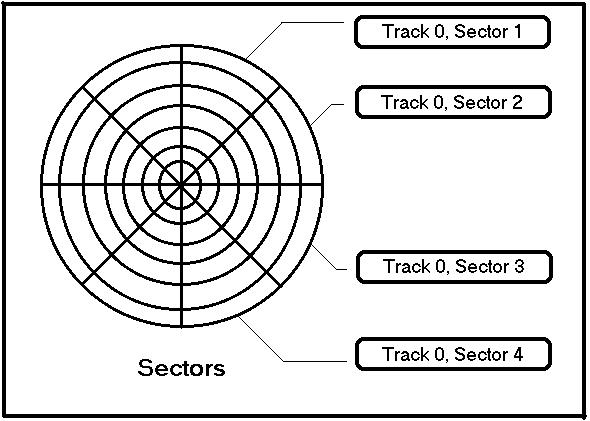- A disk is double interleaved, as in the figure bellow.
It has 8 sectors of 512 bytes per track, and a rotation rate of 300 rpm
a)How long does it take to read all the sectors of a
track in order, assuming the arm is already
correctly positioned , and 1/2 rotation is needed to
get a sector 0 under the head?
b) What's the data rate?
c) Now repeat the problem for a non-interleaved disk with the same characteristics
d) How much does the data rate degrade due to interleaving?
300 rpm means that one complete turn
takes (60 sec * 1000 ms) / 300 rpm = 200 ms
Thus one sector needs 200 ms / 8 = 25 ms
To read all the sectors in order the head has to
go over 22 sectors starting from sector 0 (0-
3-6-1-4-7-2-5-0-3-6-1-4-7-2-5-0-3-6-1-4-7)
what takes 22*25 ms = 550 ms
a) 550 ms + 200 ms / 2 = 650 ms
Effective access time = seek time + latency time +
data transfer time = 0 + 200 ms / 2 + 550 ms = 650
ms, thus
b) data rate = (8 * 512 bytes / 650 ms) * 1000 ms/sec
˜ 6302 bytes / sec
c) read all the sectors: 8*25 ms + 200 ms / 2 = 300 ms
data rate = (8 * 512 bytes / 300 ms) * 1000 ms/sec =
13653 bytes / sec
d) the difference in data rate is 13653 bytes / sec –
6302 bytes / sec = 7351 bytes / sec
http://disi.unitn.it/~ilya/Download/os_course/input_output_lab.pdf
- Disk Performance
Given the following Disk Parameters:
– Average seek time is 5 ms
– Disk spins at 10,000 RPM
– Transfer rate is 40 MB/sec
What is Average Disk read or write time for a 512-byte Sector?
Ave. seek + ave. rot delay + transfer time + controller overhead
5 ms + 0.5/(10000 RPM/60) + 0.5 KB/40 MB/s + 0.1 ms
5 + 3 + 0.13 + 0.1 = 8.23 ms
http://meseec.ce.rit.edu/eecc551-winter2003/551-exam-review-winter2003.pdf
- Performance Example
How long does it take to read a 512 byte block from the disk?
How long does it take to read two 512 byte blocks from the disk?
http://williams.comp.ncat.edu/comp375/disk.pdf
- Disk Performance Example
• Calculate time to read 512-byte sector for a disk.
Average seek time is 5ms,
the transfer rate is 40 MB/sec,
it rotates at 10,000 RPM, and
the controller overhead is 0.1 ms.
• Disk latency = average seek time +
average rotational delay + transfer time +
controller overhead
= 5 ms+ 0.5 * 1/(10000 RPM) + 512 B / (40 MB/s) + 0.1 ms
=5+3+0.013+0.1=8.11ms
https://docs.google.com/presentation/d/1zBhbZZoejmApfDjDkBvYg50DJ_4Aoq4EzGB_e_AYeLU/edit#slide=id.p5
- Disk Performance
Average Disk Access Time= average rotation time+ average seek time+data transfer time+controller overhead time.
For a disk with 7200RPM, the average rotation time= 0.5 rotations/7200RPM= 0.00415 sec
What is the average time to read/write a 512 byte sector for a typical disk:
average seeek time=9ms,
data transfer rate is 4MB/s,
RPM=7200,
controller overhead=1 ms.
Assume no queueing delay.
Ans: 9ms+(0.5/(7200/60))*1000 ms+0.5KB/4.0MB/s+1ms=9+4.15+0.125+1=14.3 ms.
http://cs.uccs.edu/~cs520/S99ch6.PDF


